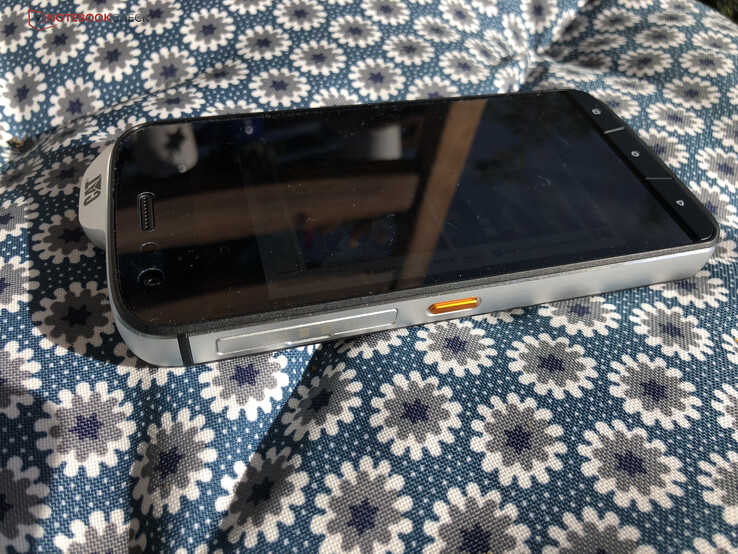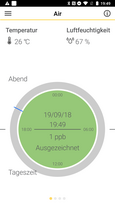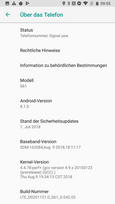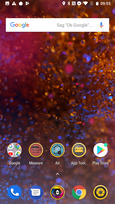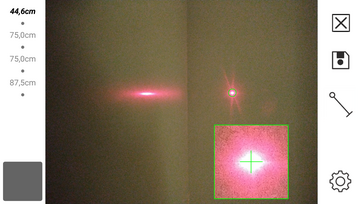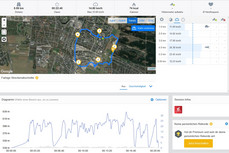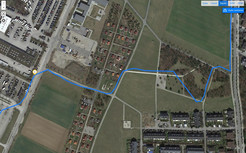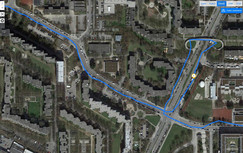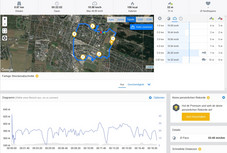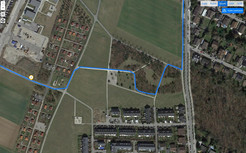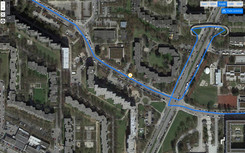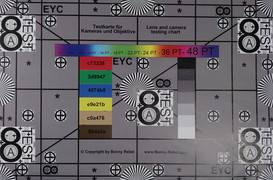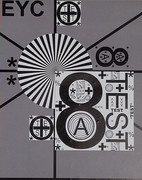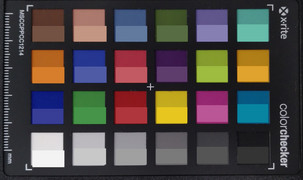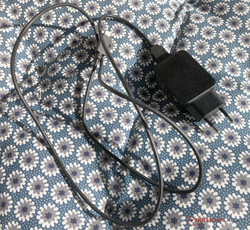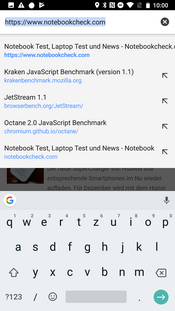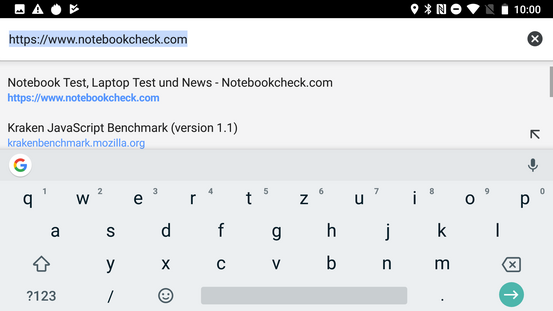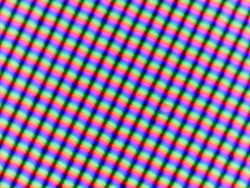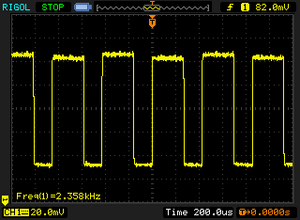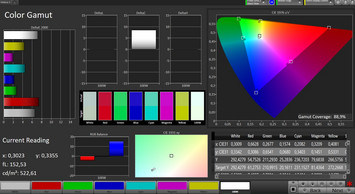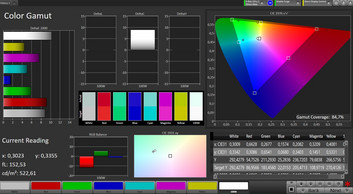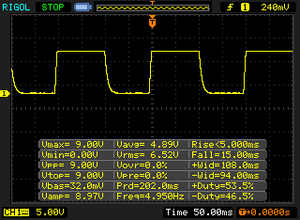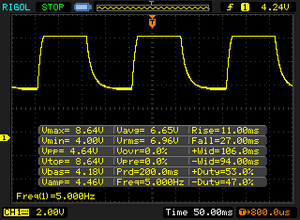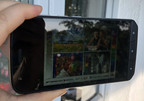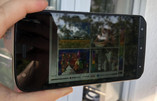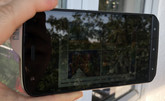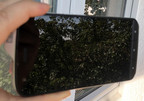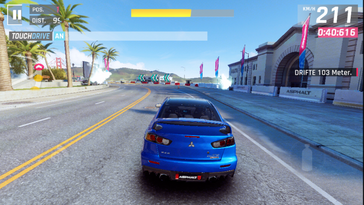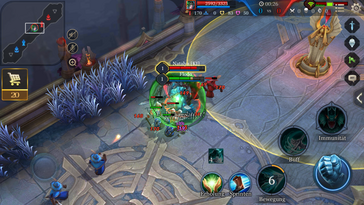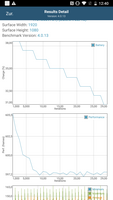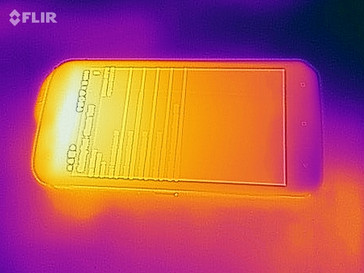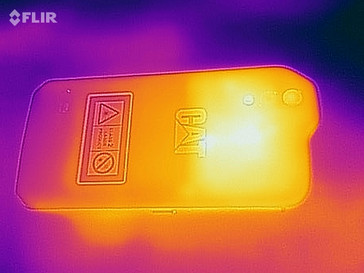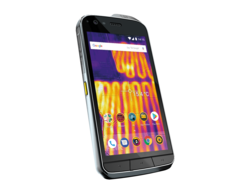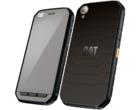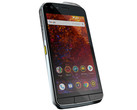CAT S61 Smartphone Review
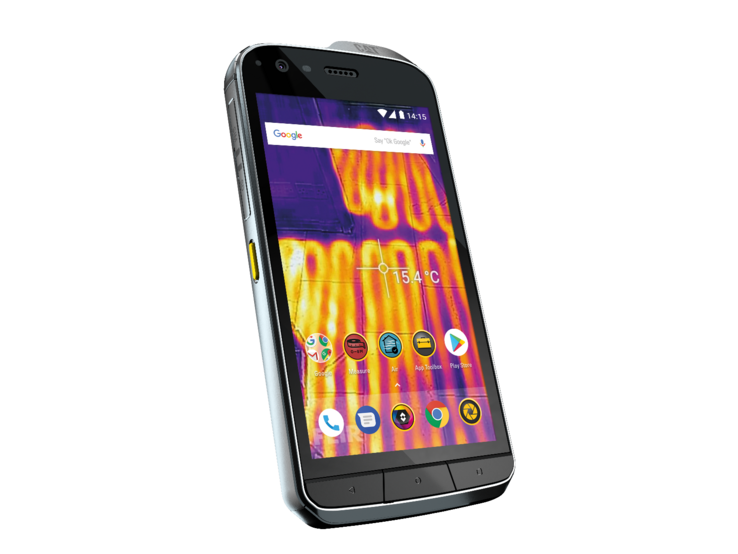
Some professionals often have to carry a lot of equipment, such as a laser distance measure to measure rooms, a thermal-imaging camera to discover leaks when insulating houses, or a device to measure indoor air quality that is particularly needed to protect one's health when using chemicals indoors. Anyone who purchases the new CAT S61 will get all these measurement devices built into the smartphone. In addition, you should also be able to operate your phone in the rain, and according to the manufacturer, it is of course also protected against shocks, drops, water, and dust.
Those are quite a lot of promises that might be very attractive to some professions in particular work areas. We want to find out in our test whether these features work well and can really replace specialized measurement devices. Of course we will also answer the question whether the CAT S61 is a good smartphone. After all, the manufacturer is asking for almost 900 Euros (~$1059; $999 in the US), a premium for which you can also get an iPhone 8. In comparison, the Land Rover Explore has less special features but is also outdoor suitable, and the Crosscall Action-X3 is more affordable. Also, what exactly are the differences to the significantly more affordable CAT S41?
Case – The CAT S61 is robust and heavy
The CAT S61 is designed to be used in situations that are difficult for other smartphones. It is water and dust-proof, has a protruding case edge in front to protect the display in case of drops, and it also survived various drop, vibration, and temperature tests. Pressure on the front or back does not bother the CAT smartphone, and it cannot be warped, nor does it produce any creaking when trying to make it do so. In order to reach such resilience, it needs space for the ruggedizing features, so that the smartphone does not really look very delicate with its relatively wide bezels around the display and the hefty 13 mm (~0.51 in) case thickness. There is even an antenna stub like we know from older devices on top. At 250 grams (~8.8 oz), the weight is also quite high.
The design is kept fairly modest and much less playful than that of the Land Rover Explore or the Crosscall Action-X3. The back has a non-slip diamond pattern, the front is black, and it has a silver frame. The fact that it is only available in a single color also suits this utilitarian design approach: The CAT S61 is not a fashionable lifestyle device but is a real workhorse.
Equipment – Special functions in the CAT smartphone
Of course, for 899 Euros (~$1058), you can get more from other smartphones than the 4 GB of RAM and 64 GB of storage offered by the CAT S61, but you are really paying for the many additional functions and the ruggedness the smartphone offers. Overall, we can just barely justify the storage equipment for this price, considering that the iPhone 8 offers even less working memory.
The storage can be expanded by up to 256 GB using microSD cards that can also formatted as internal storage. However, apps cannot be installed on that.
Unfortunately, the USB-C connection can only handle USB-2.0 speeds for data transfer, but there is NFC and a dedicated audio port.
Surely the most important features in terms of its equipment are the special functions the CAT S41 offers? For one, there is a laser measuring device that can determine distances between 1 and 8 meters (3-26 ft) in combination with the camera. While you need to initially calibrate the device, which is a little laborious, you will then have a measuring tool that is quite reliable. In addition, you can also mark some lines in a picture and the smartphone will be able to calculate their lengths. All that works quite well.
There is also a sensor for air quality, protected behind a grid on the right side of the case. In combination with the corresponding app, this can determine the air quality once every four seconds, testing the indoor air for temperature, humidity, and pollutants that are often present in solvents, glues, varnish, or cleaning supplies. However, CAT itself admits that only some particular pollutants will be recognized, but it is unable to specify anything about other gases such as for example carbon monoxide exposure. So this is rather a general tool that can give warnings about particular harmful pollutants.
In addition, there is an integrated thermal-imaging camera. This comes from FLIR, one of the most popular manufacturers of thermal-imaging cameras. You can also get the FLIR thermal-imaging cameras as a plug-in adapter for iOS and Android smartphones with USB-C port. The fact that the camera is integrated here of course saves some space, and you do not need to worry about a battery for an additional module. The thermal-imaging camera also produces good results in our short test.
Software – Reasonably current security
Basically, CAT is using a fairly pure Android 8.1 and has only installed a few particular apps that support the special functions of the smartphone. There is an app to measure the distances via laser pointer and camera, an app to measure the air quality, and FLIR to record the thermal images. The App Toolbox is a special CAT app shop with focus on the customers of the CAT S61. For example, it offers apps for anglers and other outdoor themes, or apps for professional users.
The security patches on our device are on the level of July 1, 2018, so at the time of our testing they are still barely acceptable in terms of being current.
Communication and GPS – Fast WLAN and many LTE bands
The CAT S61 offers fast WLAN according to 802.11 ac. This is the standard in its price range. The speeds of the outdoor smartphone are mediocre, and during download in particular, the iPhone 8 is much faster. We measured this with our Linksys EA8500 reference router using our standardized measuring process. The page load times are average and you have to wait for images from time to time. The connection is available in full signal strength close to the router. At 10 m (33 ft) distance and through three walls, half the signal strength remains available and loading pages takes a little longer.
In terms of LTE, not only does the CAT S61 offer a decent speed of 600 Mb/s in the download, but it also supports a bunch of LTE bands, which allows using it for travel abroad. However, the frequencies for the USA are missing, for example. In a city, reception is also available indoors. We use the fairly well developed German D2 network for our testing, and most of the time half the signal strength is available here.
| Networking | |
| iperf3 transmit AX12 | |
| Apple iPhone 8 | |
| CAT S61 | |
| Crosscall Action-X3 | |
| Land Rover Explore | |
| CAT S41 | |
| iperf3 receive AX12 | |
| Apple iPhone 8 | |
| CAT S61 | |
| Crosscall Action-X3 | |
| Land Rover Explore | |
| CAT S41 | |
Indoors in rooms with a concrete ceiling, the Caterpillar smartphone is unable to locate us, not even near the window. Outdoors, it achieves an accuracy of up to 4 meters (13 ft) after a minimal delay.
In our practice test, we take the CAT S61 on a bike tour, also packing the Garmin Edge 520 professional navigation device. The results are mixed. In some sections, the CAT S61 is slightly inaccurate, also taking some short cuts we did not take in the area around the small forest. In other sections, it is fairly accurate during the bridge crossing and its approach, even showing the side of the road where we went more accurately than the Garmin. Overall, we can recommend the CAT S61 also for more-demanding navigation tasks, since it performs on the level of a real professional navigation device.
Telephone Functions and Voice Quality of the CAT S61
While the telephone app reminds us strongly of Google's original app, it has a slightly adjusted design, and the tabs are now at the bottom. VoIP is supported by the smartphone.
The voice quality using the built-in ear piece and microphone are good. The voice of our conversation partner comes across quite clear and warm, but at higher volume levels you can hear some significant noise in the background. Via speaker phone, the voice quality of our conversation partner is still good; however, our voice now arrives sounding quite distant and a bit tinny to our conversation partner.
Cameras – CAT smartphone with solid cameras
In addition to the sensor for the thermal-imaging camera, there is also a standard single camera on the back. It has a resolution of 16 megapixels and is supported by a dual-LED flash. The images appear slightly dark and their sharpness is only mediocre. While the brightness in weak light is decent, the image sharpness drops further. Overall, the camera is at the level of the upper mid-range. It does not need to hide with its image quality for snapshots, but it is surpassed by cameras in high-end devices.
Optionally, videos can be recorded in 4K resolution. The exposure is okay here, but like in the pictures, it is slightly too dark. Colors are reproduced well and the detail reproduction and sharpness are average.
The front camera has a resolution of 8 megapixels. Under normal light conditions, it takes sharp and well-exposed images. However, in light areas some of the detail quickly gets lost.
When we verify the image quality of the main camera under controlled light conditions in our lab, we again notice that the pictures turn out fairly dark. Among dark color tones, it becomes difficult to differentiate with the naked eye. Text in front of red background becomes a challenge for the smartphone camera, but otherwise the reproduction is quite sharp. However, the sharpness decreases clearly noticeably towards the edges. The colors on the color chart are also reproduced slightly too dark.
Accessories and Warranty – Not much in the box
The manufacturer is a bit stingy with the included accessories. There is only a quick charger and USB cable in the box, accompanied by the usual writing material. In general, we like that you do not need any tools for the SIM tray but that you can open it with your fingernail. However, it sits quite tightly in the case, causing us to prefer using a screwdriver to protect our nails. While the manufacturer offers accessories on its website, these are some generic accessories, such as a power bank or a car charging cable that you can also get from third-party vendors.
The warranty is 24 months. CAT offers a two-year warranty for the glass screen, and there is a free pickup service and the promise to return the device to the customer within five days. Please see our Guarantees, Return policies and Warranties FAQ for country-specific information.
Input Devices and Operation– Physical buttons on the CAT S61
Although the touchscreen is particularly robust, it can be operated easily, and due to the relatively large bezels, the case edge that has been raised to protect the screen is also no hindrance. The touchscreen is quite responsive even at the edges and in the corners. The smartphone also has a glove mode but doesn't have a fingerprint sensor. This is probably related to the needs of the professional users, since companies usually use RFID cards that can communicate via NFC with the device for authentication.
On the other hand, there are several physical keys on the device. For example, the Android navigation keys below the display are real buttons. They offer a clear feedback via the key pressure and appear fairly high-quality. On the left side of the case is an orange key that can be programmed freely for use of an app, or it can also be used as a push-to-talk button, if you install the corresponding app. On the right side is the standby button and below that, the volume keys. The keys are fairly large and have a considerable distance from each other, so that they can easily be operated even when wearing gloves.
Display – 16:9 and very bright
The IPS display in the CAT smartphone has a resolution of 1920x1080 pixels and is a classic 16:9 display in the 5.2-inch format, so its whole area can be used for 16:9 content such as videos. At an average brightness of 672 cd/m², the display of the CAT S61 can be very bright if needed. At 90%, the brightness distribution is also quite even.
We notice a significant display flickering below 20% brightness. However, thanks to its high frequency this should not be problematic even for sensitive people.
| |||||||||||||||||||||||||
Brightness Distribution: 90 %
Center on Battery: 693 cd/m²
Contrast: 900:1 (Black: 0.77 cd/m²)
ΔE ColorChecker Calman: 5.23 | ∀{0.5-29.43 Ø4.78}
ΔE Greyscale Calman: 6.9 | ∀{0.09-98 Ø5}
84.7% sRGB (Calman 2D)
Gamma: 2.834
CCT: 7137 K
| CAT S61 IPS, 1920x1080, 5.2" | Land Rover Explore IPS, 1920x1080, 5" | Crosscall Action-X3 IPS, 1280x800, 5" | Apple iPhone 8 IPS True Tone, 1334x750, 4.7" | CAT S41 IPS, 1920x1080, 5" | |
|---|---|---|---|---|---|
| Screen | -15% | 3% | 38% | -7% | |
| Brightness middle (cd/m²) | 693 | 633 -9% | 417 -40% | 604 -13% | 537 -23% |
| Brightness (cd/m²) | 672 | 604 -10% | 425 -37% | 580 -14% | 506 -25% |
| Brightness Distribution (%) | 90 | 91 1% | 91 1% | 91 1% | 86 -4% |
| Black Level * (cd/m²) | 0.77 | 0.84 -9% | 0.29 62% | 0.44 43% | 0.9 -17% |
| Contrast (:1) | 900 | 754 -16% | 1438 60% | 1373 53% | 597 -34% |
| Colorchecker dE 2000 * | 5.23 | 6.41 -23% | 7.12 -36% | 1.2 77% | 5.02 4% |
| Colorchecker dE 2000 max. * | 10.18 | 11.88 -17% | 10.19 -0% | 2.3 77% | 7.98 22% |
| Greyscale dE 2000 * | 6.9 | 9.2 -33% | 6.1 12% | 1.6 77% | 5.3 23% |
| Gamma | 2.834 78% | 1.927 114% | 2.687 82% | 2.25 98% | 2.154 102% |
| CCT | 7137 91% | 6165 105% | 7687 85% | 6688 97% | 7226 90% |
* ... smaller is better
Screen Flickering / PWM (Pulse-Width Modulation)
| Screen flickering / PWM detected | 2358 Hz | ≤ 20 % brightness setting | |
The display backlight flickers at 2358 Hz (worst case, e.g., utilizing PWM) Flickering detected at a brightness setting of 20 % and below. There should be no flickering or PWM above this brightness setting. The frequency of 2358 Hz is quite high, so most users sensitive to PWM should not notice any flickering. In comparison: 53 % of all tested devices do not use PWM to dim the display. If PWM was detected, an average of 8108 (minimum: 5 - maximum: 343500) Hz was measured. | |||
A black value of 0.77 cd/m² is of course less enjoyable, so the contrast ratio is only average at 900:1. The gray tones are covered by a blue tint with a slight green hue, and the color accuracy is rather mediocre overall for colors and gray tones. At least the display can reproduce almost the whole sRGB color space.
Display Response Times
| ↔ Response Time Black to White | ||
|---|---|---|
| 20 ms ... rise ↗ and fall ↘ combined | ↗ 5 ms rise | |
| ↘ 15 ms fall | ||
| The screen shows good response rates in our tests, but may be too slow for competitive gamers. In comparison, all tested devices range from 0.1 (minimum) to 240 (maximum) ms. » 42 % of all devices are better. This means that the measured response time is similar to the average of all tested devices (20.2 ms). | ||
| ↔ Response Time 50% Grey to 80% Grey | ||
| 38 ms ... rise ↗ and fall ↘ combined | ↗ 11 ms rise | |
| ↘ 27 ms fall | ||
| The screen shows slow response rates in our tests and will be unsatisfactory for gamers. In comparison, all tested devices range from 0.165 (minimum) to 636 (maximum) ms. » 54 % of all devices are better. This means that the measured response time is worse than the average of all tested devices (31.6 ms). | ||
Due to the high brightness, the CAT S61 can be used easily outdoors, but you have to arrange yourself carefully in regard to reflections due to the glossy display. In our test, the brightness sensor reacts to light changes fast and reliably.
We did not notice any brightness shifts on the IPS display of the CAT smartphone on viewing angles from the sides.
Performance – The CAT S61 is faster than many outdoor smartphones
Thanks to the Qualcomm Snapdragon 630, the CAT S61 outdoor smartphone offers good performance values that are quite suitable for the upper mid-range. It is at about the same level as the Land Rover Explore in terms of its performance, and we did not notice any stutters or delays during the test. On the other hand, the performance difference to the CAT S41 is clearly visible.
The Adreno 508 is used as the graphics unit, and while here the CAT S61 cannot quite keep up with the Land Rover Explore in the benchmarks, it still remains on a high level.
| AnTuTu v6 - Total Score (sort by value) | |
| CAT S61 | |
| Land Rover Explore | |
| Crosscall Action-X3 | |
| Apple iPhone 8 | |
| Average Qualcomm Snapdragon 630 (44128 - 73617, n=12) | |
| AnTuTu v7 - Total Score (sort by value) | |
| CAT S61 | |
| Land Rover Explore | |
| Crosscall Action-X3 | |
| Average Qualcomm Snapdragon 630 (87300 - 90674, n=11) | |
| PCMark for Android | |
| Work performance score (sort by value) | |
| CAT S61 | |
| Land Rover Explore | |
| Crosscall Action-X3 | |
| CAT S41 | |
| Average Qualcomm Snapdragon 630 (4948 - 6264, n=13) | |
| Work 2.0 performance score (sort by value) | |
| CAT S61 | |
| Land Rover Explore | |
| Crosscall Action-X3 | |
| CAT S41 | |
| Average Qualcomm Snapdragon 630 (4636 - 5987, n=12) | |
| GFXBench 3.0 | |
| on screen Manhattan Onscreen OGL (sort by value) | |
| CAT S61 | |
| Land Rover Explore | |
| Crosscall Action-X3 | |
| Apple iPhone 8 | |
| CAT S41 | |
| Average Qualcomm Snapdragon 630 (11 - 15, n=13) | |
| Average of class Smartphone (18 - 166, n=159, last 2 years) | |
| 1920x1080 1080p Manhattan Offscreen (sort by value) | |
| CAT S61 | |
| Land Rover Explore | |
| Crosscall Action-X3 | |
| Apple iPhone 8 | |
| CAT S41 | |
| Average Qualcomm Snapdragon 630 (13 - 14, n=13) | |
| Average of class Smartphone (12 - 606, n=158, last 2 years) | |
| GFXBench 3.1 | |
| on screen Manhattan ES 3.1 Onscreen (sort by value) | |
| CAT S61 | |
| Land Rover Explore | |
| Crosscall Action-X3 | |
| Apple iPhone 8 | |
| CAT S41 | |
| Average Qualcomm Snapdragon 630 (5.3 - 11, n=13) | |
| Average of class Smartphone (11 - 166, n=159, last 2 years) | |
| 1920x1080 Manhattan ES 3.1 Offscreen (sort by value) | |
| CAT S61 | |
| Land Rover Explore | |
| Crosscall Action-X3 | |
| Apple iPhone 8 | |
| CAT S41 | |
| Average Qualcomm Snapdragon 630 (5.2 - 10, n=13) | |
| Average of class Smartphone (8.4 - 413, n=158, last 2 years) | |
In the browser benchmarks, the CAT S61 performs at an average speed, looking at the comparison field. The iPhone 8 is much faster on the net, and the Land Rover Explore is also able to complete the benchmarks slightly faster than our test unit. The CAT S41 is a bit slower than its bigger sibling, but the differences are only marginal here.
Demanding HTML5 content such as Google's Interland run absolutely smoothly and with fast load times.
| JetStream 1.1 - Total Score | |
| Apple iPhone 8 | |
| Land Rover Explore (Chrome 67) | |
| Average Qualcomm Snapdragon 630 (27.4 - 30.8, n=12) | |
| CAT S61 (Chrome 68) | |
| CAT S41 (Chrome 67) | |
| Crosscall Action-X3 (Chrome 68) | |
| Octane V2 - Total Score | |
| Average of class Smartphone (2228 - 121337, n=201, last 2 years) | |
| Apple iPhone 8 | |
| Land Rover Explore (Chrome 67) | |
| CAT S61 (Chrome 68) | |
| CAT S41 (Chrome 67) | |
| Average Qualcomm Snapdragon 630 (4398 - 5202, n=13) | |
| Crosscall Action-X3 (Chrome 68) | |
| Mozilla Kraken 1.1 - Total | |
| Crosscall Action-X3 (Chrome 68) | |
| CAT S41 (Chrome 67) | |
| Average Qualcomm Snapdragon 630 (8396 - 10257, n=13) | |
| CAT S61 (Chrome 68) | |
| Land Rover Explore (Chrome 67) | |
| Average of class Smartphone (257 - 28190, n=156, last 2 years) | |
| Apple iPhone 8 | |
| WebXPRT 2015 - Overall | |
| Apple iPhone 8 | |
| Land Rover Explore (Chrome 67) | |
| CAT S61 (Chrome 68) | |
| Average Qualcomm Snapdragon 630 (86 - 117, n=10) | |
* ... smaller is better
We perform an analysis of the storage speed by running AndroBench on our test unit. Considering its price, it is unfortunate that the CAT S61 only has built-in eMMC storage. But at least the access rates are above those of the comparison devices that also use this kind of storage.
We test the microSD storage card access rates by using our Toshiba Exceria Pro M501 reference storage card. The values are typical for it and attest quite fast access.
| CAT S61 | Land Rover Explore | Crosscall Action-X3 | CAT S41 | Average 64 GB eMMC Flash | Average of class Smartphone | |
|---|---|---|---|---|---|---|
| AndroBench 3-5 | -23% | -15% | -31% | 21% | 1033% | |
| Sequential Read 256KB (MB/s) | 284.7 | 237.3 -17% | 264.7 -7% | 253 -11% | 277 ? -3% | 2226 ? 682% |
| Sequential Write 256KB (MB/s) | 212.2 | 104.5 -51% | 139.3 -34% | 117.2 -45% | 178.4 ? -16% | 1848 ? 771% |
| Random Read 4KB (MB/s) | 44.7 | 28.7 -36% | 47 5% | 65.5 47% | 60.7 ? 36% | 295 ? 560% |
| Random Write 4KB (MB/s) | 15.1 | 11.2 -26% | 8.4 -44% | 12.99 -14% | 33.8 ? 124% | 335 ? 2119% |
| Sequential Read 256KB SDCard (MB/s) | 83.4 ? | 75.2 ? -10% | 84.1 ? 1% | 23.87 -71% | 77.4 ? -7% | |
| Sequential Write 256KB SDCard (MB/s) | 63.3 ? | 66.3 ? 5% | 56.2 ? -11% | 5 -92% | 58.3 ? -8% |
Games – Outdoor gaming?
While the CAT S61 is no dedicated gaming smartphone, it does quite well in this category. In our two test games Arena of Valor and Asphalt 9, which we test with the GameBench app, the smartphone reaches 30 FPS quite reliably. Only at high graphics settings are there some frame rate drops at times.
The control via touchscreen and position sensor also works quite well in the games we tested.
| Asphalt 9: Legends | |||
| Settings | Value | ||
| High Quality | 30 fps | ||
| Standard / low | 30 fps | ||
| Arena of Valor | |||
| Settings | Value | ||
| min | 31 fps | ||
| high HD | 31 fps | ||
Emissions – High heat development and good speaker
Temperature
Under maximum load, the device heats up to a maximum of 43.3 °C (~110 °F) in the upper front area, after the device is in use for a while. Since the warming is clearly noticeable, you might not feel like putting the smartphone near your ear anymore. However, this value is not dangerous, since the warming is locally very limited to the top area of the smartphone. In idle mode it warms up much less, and you can hardly feel it with your hand.
Using the battery test of GFXBench, we can evaluate whether the device is still able to maintain its full performance even after longer use. Indeed, the performance hardly drops even after 30 runs of the benchmark, so that we can assume the CAT S61 does not throttle under load.
(±) The maximum temperature on the upper side is 43.3 °C / 110 F, compared to the average of 35.2 °C / 95 F, ranging from 21.9 to 247 °C for the class Smartphone.
(±) The bottom heats up to a maximum of 42.5 °C / 109 F, compared to the average of 34 °C / 93 F
(+) In idle usage, the average temperature for the upper side is 29 °C / 84 F, compared to the device average of 32.9 °C / 91 F.
Speaker
The speaker characteristic is very similar to that of the CAT S41, so that the conclusion lends itself that the manufacturer builds the same speaker into both devices. In very loud surroundings, its power will not be sufficient to still be able to hear anything, but at a maximum of 79.4 dB(A) it is sufficiently loud for medium-sized rooms.
The sound quality is average. While the speaker does not boom even at maximum volume, music and voices do not sound very clear either. Low mids are barely present, but the sound is quite warm overall.
You can connect a headset, headphones, or a speaker to the device via the 3.5 mm audio port or Bluetooth 5.0. Both ways work flawlessly and deliver a clean sound.
CAT S61 audio analysis
(±) | speaker loudness is average but good (79.4 dB)
Bass 100 - 315 Hz
(-) | nearly no bass - on average 20.9% lower than median
(±) | linearity of bass is average (9.1% delta to prev. frequency)
Mids 400 - 2000 Hz
(+) | balanced mids - only 3.8% away from median
(+) | mids are linear (6.2% delta to prev. frequency)
Highs 2 - 16 kHz
(+) | balanced highs - only 3.3% away from median
(+) | highs are linear (4.6% delta to prev. frequency)
Overall 100 - 16.000 Hz
(±) | linearity of overall sound is average (20% difference to median)
Compared to same class
» 32% of all tested devices in this class were better, 9% similar, 60% worse
» The best had a delta of 11%, average was 35%, worst was 134%
Compared to all devices tested
» 50% of all tested devices were better, 8% similar, 41% worse
» The best had a delta of 4%, average was 24%, worst was 134%
CAT S41 audio analysis
(±) | speaker loudness is average but good (80.1 dB)
Bass 100 - 315 Hz
(-) | nearly no bass - on average 61.7% lower than median
(+) | bass is linear (0% delta to prev. frequency)
Mids 400 - 2000 Hz
(-) | nearly no mids - on average 61.7% lower than median
(+) | mids are linear (0% delta to prev. frequency)
Highs 2 - 16 kHz
(-) | nearly no highs - on average 61.7% lower than median
(+) | highs are linear (0% delta to prev. frequency)
Overall 100 - 16.000 Hz
(-) | overall sound is not linear (117.2% difference to median)
Compared to same class
» 87% of all tested devices in this class were better, 6% similar, 6% worse
» The best had a delta of 11%, average was 35%, worst was 134%
Compared to all devices tested
» 96% of all tested devices were better, 2% similar, 2% worse
» The best had a delta of 4%, average was 24%, worst was 134%
Battery Life – The CAT S61 with a lasting battery
Power Consumption
Even though the CAT S61 is not very efficient with its minimum idle consumption, it scores with low consumption values in all the other measurement categories. Considering the performance capabilities, the maximum load consumption is pleasantly low. Although the iPhone 8 is still the efficiency king, the CAT S61 also fares very well overall.
| Off / Standby | |
| Idle | |
| Load |
|
Key:
min: | |
| CAT S61 4500 mAh | Land Rover Explore 4000 mAh | Crosscall Action-X3 3500 mAh | Apple iPhone 8 1821 mAh | CAT S41 5000 mAh | Average Qualcomm Snapdragon 630 | Average of class Smartphone | |
|---|---|---|---|---|---|---|---|
| Power Consumption | -13% | -16% | 19% | -11% | 12% | -20% | |
| Idle Minimum * (Watt) | 1.4 | 1.2 14% | 1.1 21% | 0.54 61% | 1.4 -0% | 0.732 ? 48% | 0.848 ? 39% |
| Idle Average * (Watt) | 1.9 | 1.5 21% | 1.9 -0% | 1.63 14% | 2.2 -16% | 1.835 ? 3% | 1.434 ? 25% |
| Idle Maximum * (Watt) | 2.6 | 3 -15% | 2.9 -12% | 1.67 36% | 2.8 -8% | 2.16 ? 17% | 1.618 ? 38% |
| Load Average * (Watt) | 3.5 | 4.5 -29% | 4.8 -37% | 2.74 22% | 4.1 -17% | 3.81 ? -9% | 7.01 ? -100% |
| Load Maximum * (Watt) | 5.6 | 8.6 -54% | 8.4 -50% | 7.78 -39% | 6.4 -14% | 5.62 ? -0% | 11.3 ? -102% |
* ... smaller is better
Battery Life
With 4500 mAh, the battery has less capacity than the one found in the CAT S41. This might be due to all the special feature equipment that naturally also needs space in the case. Yet in the realistic WLAN test, the battery life is not much worse than in the smaller CAT model: There is only half-an-hour difference between both smartphones. 15:23 hours is a very good value for the CAT S61, and the smartphone also does well under load, which we already expected, seeing its low power consumption. Thus several days without a charger during normal use should not be a problem with the CAT S61. Even when used constantly, the device has sufficient reserves for a workday and longer, despite its built-in battery.
You can quickly charge the smartphone via QuickCharge 3.0: The included charger needs barely two hours for a complete charging cycle.
| CAT S61 4500 mAh | Land Rover Explore 4000 mAh | Crosscall Action-X3 3500 mAh | Apple iPhone 8 1821 mAh | CAT S41 5000 mAh | |
|---|---|---|---|---|---|
| Battery runtime | -43% | -8% | -29% | 3% | |
| Reader / Idle (h) | 31.5 | 27.2 -14% | |||
| H.264 (h) | 16 | 11.6 -27% | |||
| WiFi v1.3 (h) | 15.4 | 8.8 -43% | 14.1 -8% | 9.8 -36% | 15.9 3% |
| Load (h) | 5.7 | 3.4 -40% |
Pros
Cons
Verdict – Special tool with many qualities
The CAT S61 is of course a specialist. With its hefty exterior and the very specific additional functionalities, it is not really a smartphone for everyone. But anyone who often uses a thermal-imaging camera might enjoy the built-in solution. The distance measure via laser also works well, even if it is not quite as smooth as a dedicated device.
Anyone attracted by laser distance measurement, air quality measurement, and a thermal-imaging camera will get a versatile tool into their hands with the CAT S61.
Naturally, other features are important for professionals than for regular customers, but the display and the camera of the CAT S61 are quite usable. Likewise, the performance is okay, there is sufficient storage, and the GPS also works quite accurately. While the CAT S61 can be used in many areas, for someone who does not use its additional functionalities, there are better choices in the price range of this smartphone: With more performance, more storage, and better cameras. There are also more affordable ruggedized phones such as the Land Rover Explore or the CAT S41, if you are only looking for a robust smartphone.
Overall, the CAT S61 is a versatile device that is worth its price, as long as you are also going to use its special features.
CAT S61
- 10/16/2019 v7 (old)
Florian Wimmer




